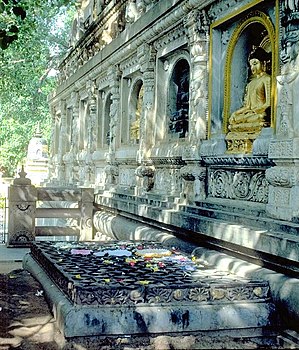Bodhimaṇḍa
bodhimaṇḍa (T. byang chub snying po བྱང་ཆུབ་སྙིང་པོ; C. daochang 道場) is translated as "seat of awakening," "seat of enlightenment," "position of awakening," etc. It is a sacred place or "seat" where all buddhas-to-be go and and sit to reach the final stage of buddhahood.
The bodhimanda for Gautama Buddha was under the Bodhi tree in Bodhgaya, where he sat when he attained enlightenment (bodhi).[1]
The bodhimanda is also known as the "vajra seat" (vajrāsana).
Robert Thurman described the bodhimanda as "the seat of enlightenment, wherein is concentrated the essence of enlightenment."[2]
In the Vimalakirti Sutra, the bodhimanda is described on a conceptual level, and is correlated with the six paramitas, the four immeasurables, etc.[3]
The Tibetan term for bodhimanda, byang chub snying po, also has the meaning of "essence of enlightenment."[4]
In East Asian Buddhism, the Chinese term for bodhimandala, daochang, is also used in a more general sense to refer to a site for rituals, or to a monastery.[1]
References
- ↑ 1.0 1.1 Robert E. Buswell Jr., Donald S. Lopez Jr., The Princeton Dictionary of Buddhism (Princeton: 2014), s.v. bodhimaṇḍa
- ↑ Thurman, Robert (1992). The Holy Teaching of Vimalakīrti: A Mahāyāna Scripture. Pennsylvania State University Press. p. 138.
- ↑ Thurman, Robert (1992). The Holy Teaching of Vimalakīrti: A Mahāyāna Scripture. Pennsylvania State University Press, Chapter 4
- ↑
 byang_chub_snying_po, Rangjung Yeshe Wiki
byang_chub_snying_po, Rangjung Yeshe Wiki
